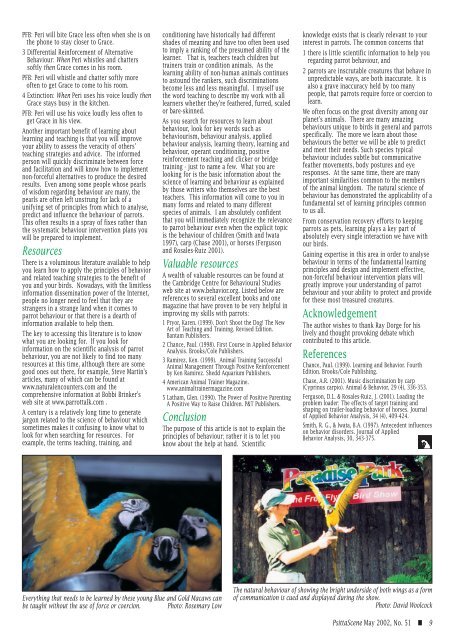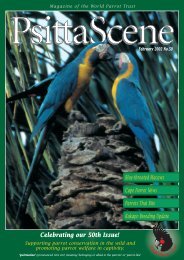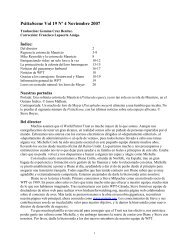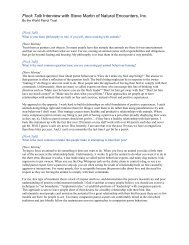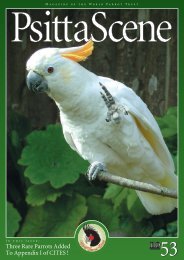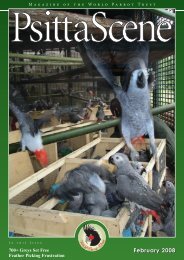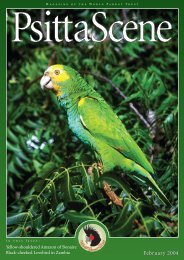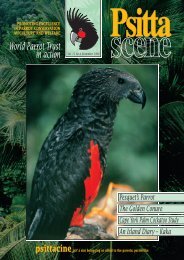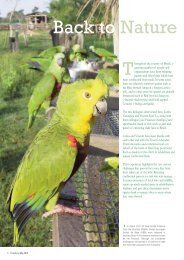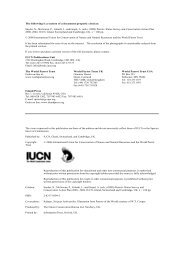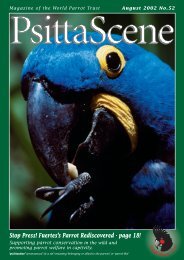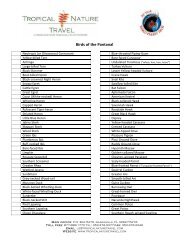Parrots in the Wild - World Parrot Trust
Parrots in the Wild - World Parrot Trust
Parrots in the Wild - World Parrot Trust
Create successful ePaper yourself
Turn your PDF publications into a flip-book with our unique Google optimized e-Paper software.
PFB: Peri will bite Grace less often when she is on<br />
<strong>the</strong> phone to stay closer to Grace.<br />
3 Differential Re<strong>in</strong>forcement of Alternative<br />
Behaviour: When Peri whistles and chatters<br />
softly <strong>the</strong>n Grace comes <strong>in</strong> his room.<br />
PFB: Peri will whistle and chatter softly more<br />
often to get Grace to come to his room.<br />
4 Ext<strong>in</strong>ction: When Peri uses his voice loudly <strong>the</strong>n<br />
Grace stays busy <strong>in</strong> <strong>the</strong> kitchen.<br />
PFB: Peri will use his voice loudly less often to<br />
get Grace <strong>in</strong> his view.<br />
Ano<strong>the</strong>r important benefit of learn<strong>in</strong>g about<br />
learn<strong>in</strong>g and teach<strong>in</strong>g is that you will improve<br />
your ability to assess <strong>the</strong> veracity of o<strong>the</strong>rs'<br />
teach<strong>in</strong>g strategies and advice. The <strong>in</strong>formed<br />
person will quickly discrim<strong>in</strong>ate between force<br />
and facilitation and will know how to implement<br />
non-forceful alternatives to produce <strong>the</strong> desired<br />
results. Even among some people whose pearls<br />
of wisdom regard<strong>in</strong>g behaviour are many, <strong>the</strong><br />
pearls are often left unstrung for lack of a<br />
unify<strong>in</strong>g set of pr<strong>in</strong>ciples from which to analyse,<br />
predict and <strong>in</strong>fluence <strong>the</strong> behaviour of parrots.<br />
This often results <strong>in</strong> a spray of fixes ra<strong>the</strong>r than<br />
<strong>the</strong> systematic behaviour <strong>in</strong>tervention plans you<br />
will be prepared to implement.<br />
Resources<br />
There is a volum<strong>in</strong>ous literature available to help<br />
you learn how to apply <strong>the</strong> pr<strong>in</strong>ciples of behavior<br />
and related teach<strong>in</strong>g strategies to <strong>the</strong> benefit of<br />
you and your birds. Nowadays, with <strong>the</strong> limitless<br />
<strong>in</strong>formation dissem<strong>in</strong>ation power of <strong>the</strong> Internet,<br />
people no longer need to feel that <strong>the</strong>y are<br />
strangers <strong>in</strong> a strange land when it comes to<br />
parrot behaviour or that <strong>the</strong>re is a dearth of<br />
<strong>in</strong>formation available to help <strong>the</strong>m.<br />
The key to access<strong>in</strong>g this literature is to know<br />
what you are look<strong>in</strong>g for. If you look for<br />
<strong>in</strong>formation on <strong>the</strong> scientific analysis of parrot<br />
behaviour, you are not likely to f<strong>in</strong>d too many<br />
resources at this time, although <strong>the</strong>re are some<br />
good ones out <strong>the</strong>re, for example, Steve Mart<strong>in</strong>'s<br />
articles, many of which can be found at<br />
www.naturalencounters.com and <strong>the</strong><br />
comprehensive <strong>in</strong>formation at Bobbi Br<strong>in</strong>ker's<br />
web site at www.parrottalk.com .<br />
A century is a relatively long time to generate<br />
jargon related to <strong>the</strong> science of behaviour which<br />
sometimes makes it confus<strong>in</strong>g to know what to<br />
look for when search<strong>in</strong>g for resources. For<br />
example, <strong>the</strong> terms teach<strong>in</strong>g, tra<strong>in</strong><strong>in</strong>g, and<br />
condition<strong>in</strong>g have historically had different<br />
shades of mean<strong>in</strong>g and have too often been used<br />
to imply a rank<strong>in</strong>g of <strong>the</strong> presumed ability of <strong>the</strong><br />
learner. That is, teachers teach children but<br />
tra<strong>in</strong>ers tra<strong>in</strong> or condition animals. As <strong>the</strong><br />
learn<strong>in</strong>g ability of non-human animals cont<strong>in</strong>ues<br />
to astound <strong>the</strong> rankers, such discrim<strong>in</strong>ations<br />
become less and less mean<strong>in</strong>gful. I myself use<br />
<strong>the</strong> word teach<strong>in</strong>g to describe my work with all<br />
learners whe<strong>the</strong>r <strong>the</strong>y're fea<strong>the</strong>red, furred, scaled<br />
or bare-sk<strong>in</strong>ned.<br />
As you search for resources to learn about<br />
behaviour, look for key words such as<br />
behaviourism, behaviour analysis, applied<br />
behaviour analysis, learn<strong>in</strong>g <strong>the</strong>ory, learn<strong>in</strong>g and<br />
behaviour, operant condition<strong>in</strong>g, positive<br />
re<strong>in</strong>forcement teach<strong>in</strong>g and clicker or bridge<br />
tra<strong>in</strong><strong>in</strong>g - just to name a few. What you are<br />
look<strong>in</strong>g for is <strong>the</strong> basic <strong>in</strong>formation about <strong>the</strong><br />
science of learn<strong>in</strong>g and behaviour as expla<strong>in</strong>ed<br />
by those writers who <strong>the</strong>mselves are <strong>the</strong> best<br />
teachers. This <strong>in</strong>formation will come to you <strong>in</strong><br />
many forms and related to many different<br />
species of animals. I am absolutely confident<br />
that you will immediately recognize <strong>the</strong> relevance<br />
to parrot behaviour even when <strong>the</strong> explicit topic<br />
is <strong>the</strong> behaviour of children (Smith and Iwata<br />
1997), carp (Chase 2001), or horses (Ferguson<br />
and Rosales-Ruiz 2001).<br />
Valuable resources<br />
A wealth of valuable resources can be found at<br />
<strong>the</strong> Cambridge Centre for Behavioural Studies<br />
web site at www.behavior.org. Listed below are<br />
references to several excellent books and one<br />
magaz<strong>in</strong>e that have proven to be very helpful <strong>in</strong><br />
improv<strong>in</strong>g my skills with parrots:<br />
1 Pryor, Karen. (1999). Don't Shoot <strong>the</strong> Dog! The New<br />
Art of Teach<strong>in</strong>g and Tra<strong>in</strong><strong>in</strong>g. Revised Edition.<br />
Bantam Publishers.<br />
2 Chance, Paul. (1998). First Course <strong>in</strong> Applied Behavior<br />
Analysis. Brooks/Cole Publishers.<br />
3 Ramirez, Ken. (1999). Animal Tra<strong>in</strong><strong>in</strong>g Successful<br />
Animal Management Through Positive Re<strong>in</strong>forcement<br />
by Ken Ramirez. Shedd Aquarium Publishers.<br />
4 American Animal Tra<strong>in</strong>er Magaz<strong>in</strong>e.<br />
www.animaltra<strong>in</strong>ermagaz<strong>in</strong>e.com<br />
5 Latham, Glen. (1990). The Power of Positive Parent<strong>in</strong>g<br />
A Positive Way to Raise Children. P&T Publishers.<br />
Conclusion<br />
The purpose of this article is not to expla<strong>in</strong> <strong>the</strong><br />
pr<strong>in</strong>ciples of behaviour; ra<strong>the</strong>r it is to let you<br />
know about <strong>the</strong> help at hand. Scientific<br />
knowledge exists that is clearly relevant to your<br />
<strong>in</strong>terest <strong>in</strong> parrots. The common concerns that<br />
1 <strong>the</strong>re is little scientific <strong>in</strong>formation to help you<br />
regard<strong>in</strong>g parrot behaviour, and<br />
2 parrots are <strong>in</strong>scrutable creatures that behave <strong>in</strong><br />
unpredictable ways, are both <strong>in</strong>accurate. It is<br />
also a grave <strong>in</strong>accuracy held by too many<br />
people, that parrots require force or coercion to<br />
learn.<br />
We often focus on <strong>the</strong> great diversity among our<br />
planet's animals. There are many amaz<strong>in</strong>g<br />
behaviours unique to birds <strong>in</strong> general and parrots<br />
specifically. The more we learn about those<br />
behaviours <strong>the</strong> better we will be able to predict<br />
and meet <strong>the</strong>ir needs. Such species typical<br />
behaviour <strong>in</strong>cludes subtle but communicative<br />
fea<strong>the</strong>r movements, body postures and eye<br />
responses. At <strong>the</strong> same time, <strong>the</strong>re are many<br />
important similarities common to <strong>the</strong> members<br />
of <strong>the</strong> animal k<strong>in</strong>gdom. The natural science of<br />
behaviour has demonstrated <strong>the</strong> applicability of a<br />
fundamental set of learn<strong>in</strong>g pr<strong>in</strong>ciples common<br />
to us all.<br />
From conservation recovery efforts to keep<strong>in</strong>g<br />
parrots as pets, learn<strong>in</strong>g plays a key part of<br />
absolutely every s<strong>in</strong>gle <strong>in</strong>teraction we have with<br />
our birds.<br />
Ga<strong>in</strong><strong>in</strong>g expertise <strong>in</strong> this area <strong>in</strong> order to analyse<br />
behaviour <strong>in</strong> terms of <strong>the</strong> fundamental learn<strong>in</strong>g<br />
pr<strong>in</strong>ciples and design and implement effective,<br />
non-forceful behaviour <strong>in</strong>tervention plans will<br />
greatly improve your understand<strong>in</strong>g of parrot<br />
behaviour and your ability to protect and provide<br />
for <strong>the</strong>se most treasured creatures.<br />
Acknowledgement<br />
The author wishes to thank Ray Dorge for his<br />
lively and thought provok<strong>in</strong>g debate which<br />
contributed to this article.<br />
References<br />
Chance, Paul. (1999). Learn<strong>in</strong>g and Behavior. Fourth<br />
Edition. Brooks/Cole Publish<strong>in</strong>g.<br />
Chase, A.R. (2001). Music discrim<strong>in</strong>ation by carp<br />
(Cypr<strong>in</strong>us carpio). Animal & Behavior, 29 (4), 336-353.<br />
Ferguson, D.L. & Rosales-Ruiz, J. (2001). Load<strong>in</strong>g <strong>the</strong><br />
problem loader: The effects of target tra<strong>in</strong><strong>in</strong>g and<br />
shap<strong>in</strong>g on trailer-load<strong>in</strong>g behavior of horses. Journal<br />
of Applied Behavior Analysis, 34 (4), 409-424.<br />
Smith, R. G., & Iwata, B.A. (1997). Antecedent <strong>in</strong>fluences<br />
on behavior disorders. Journal of Applied<br />
Behavior Analysis, 30, 343-375.<br />
Everyth<strong>in</strong>g that needs to be learned by <strong>the</strong>se young Blue and Gold Macaws can<br />
be taught without <strong>the</strong> use of force or coercion.<br />
Photo: Rosemary Low<br />
The natural behaviour of show<strong>in</strong>g <strong>the</strong> bright underside of both w<strong>in</strong>gs as a form<br />
of communication is cued and displayed dur<strong>in</strong>g <strong>the</strong> show.<br />
Photo: David Woolcock<br />
PsittaScene May 2002, No. 51 ■ 9


